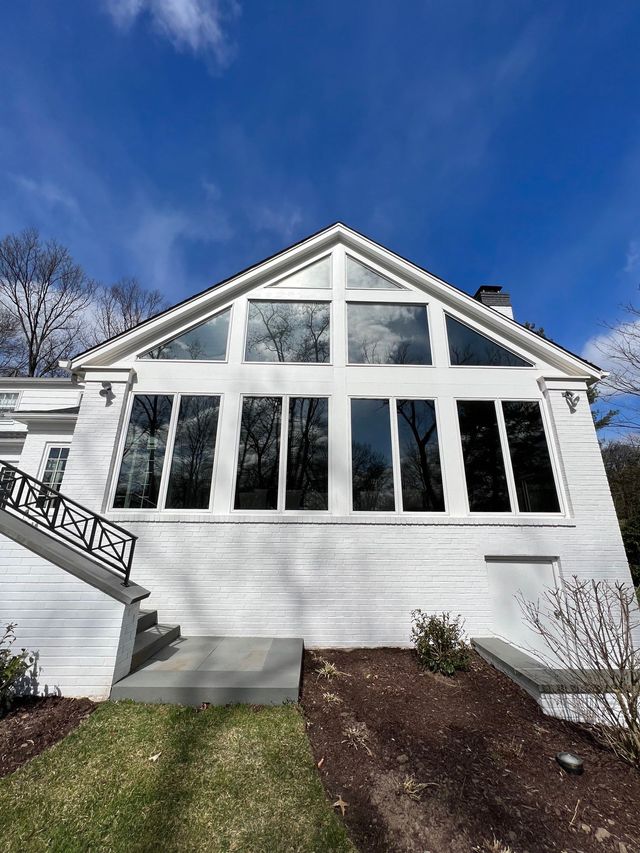How Residential Window Tinting Enhances Your Home's Power Efficiency
Residential window tinting presents an engaging service for homeowners seeking to enhance power efficiency within their living rooms. By applying specialized films to home windows, it properly decreases warm transfer, consequently maintaining interior temperatures and reducing the requirement for too much home heating or cooling.
Comprehending Window Tinting
Comprehending home window tinting is vital for house owners seeking to enhance both convenience and energy effectiveness in their home. Residential Window Tint. Home window tinting entails the application of a thin movie to the interior or exterior surface of glass windows. This movie can considerably modulate the quantity of sunlight and heat that goes into a home, hence influencing interior environment problems
There are various types of home window tinting movies available, each with unique homes. The efficiency of window tinting is usually determined by its Visible Light Transmission (VLT) percent, which shows exactly how much light can pass via the movie.
Advantages of Energy Performance
Window tinting not just improves aesthetic appeals but additionally plays a significant function in enhancing energy efficiency within residential rooms. By decreasing heat transfer through windows, colored movies create a more secure indoor climate, which can cause substantial reductions in energy intake for cooling and heating. This power efficiency translates right into lower energy costs, giving homeowners with considerable long-lasting financial savings.

Additionally, home window tinting boosts the convenience of living spaces. By lessening glare and blocking harmful UV rays, colored home windows produce an even more enjoyable atmosphere, which can cause improved well-being for residents. The security versus UV rays also assists preserve furniture and floor covering from fading, adding to the long life of home items.
Exactly How Tinting Functions
Tinting movies run with a combination of advanced materials and technologies created to manage the amount of solar power entering a home. Mostly made up of polyester, these films often integrate ceramic or metal fragments that take in and mirror heat. This double capability permits them to dramatically decrease the infiltration of ultraviolet (UV) rays and infrared radiation while permitting visible light to travel through.
The effectiveness of window tinting is gauged by its solar warmth gain coefficient (SHGC), which shows just how much solar power is transmitted with the home window. Lower SHGC values are preferable as they signify better heat being rejected. Additionally, window tints can include a range of shades, enabling home owners to tailor their aesthetic choices while enhancing power effectiveness.
Furthermore, these films function as a barrier, preventing heat loss throughout colder months by reflecting interior warmth back into the home. This thermal insulation impact complements the cooling advantages gotten throughout warmer months, adding to a balanced indoor environment year-round. By helpful resources managing solar power successfully, property home window tinting not just boosts comfort but also plays an important duty in lowering power consumption and reducing energy bills.
Picking the Right Tint

There are different kinds of window movies readily available, consisting of colored, metalized, and ceramic. Colored films are cost-effective yet may have limited durability. Metalized films provide better heat being rejected but can hinder digital signals. Ceramic movies supply exceptional warmth control without jeopardizing visibility and are very sturdy, making them a preferred option.
Noticeable light transmission (VLT) is one more important aspect, as it shows the amount of natural light that can go through the colored glass. Home owners should pick a color with a VLT that matches their lighting choices while still providing appropriate glow decrease.
Additionally, assessing the solar warmth gain coefficient (SHGC) can assist establish exactly how well a color can block heat from sunlight. A reduced SHGC shows far better warmth control, eventually improving power effectiveness.
Setup and Upkeep Tips
Correct installment and maintenance are vital elements in making best use of the advantages of residential window tinting. To attain optimum results, it is advisable to employ a certified expert for installation. This makes certain that the color is applied properly, preventing air bubbles, wrinkles, or imbalance that can compromise performance. Experts also use specialized devices and techniques, which can improve the durability and efficiency of the tint.
Following setup, upkeep is necessary to prolong the life of the home window film. It is recommended to wait at least 30 days prior to cleaning the tinted windows to permit the sticky to treat completely.
Furthermore, routine evaluations are helpful. Check for any type of peeling or bubbling, which could indicate incorrect installation or use in time - Residential Window Tint. Resolving these issues immediately can protect against further you can check here damages and preserve energy efficiency. By adhering to these installment and maintenance pointers, house owners can guarantee their home window tinting proceeds to provide significant power cost savings and convenience for several years ahead.
Verdict
Finally, residential window tinting acts as a reliable remedy for boosting energy efficiency within homes. By lowering warmth transfer and blocking dangerous UV rays, window movies add to decrease energy consumption and boosted indoor comfort. The selection of ideal tinting products, in addition to appropriate installation and upkeep, further optimizes these advantages. Eventually, home window tinting stands for a lasting financial investment that not just decreases energy bills but also promotes a comfy living setting throughout the year.
Home window tinting involves the application of a thin film to the interior or outside surface area of glass home windows. By decreasing warmth transfer via windows, tinted movies produce an extra secure interior environment, which can lead to check out here considerable reductions in energy intake for home heating and cooling.The efficiency of window tinting is measured by its solar heat gain coefficient (SHGC), which shows how much solar power is sent with the window. By managing solar power efficiently, domestic window tinting not just boosts convenience however additionally plays an important role in reducing energy usage and decreasing utility costs.
By minimizing warm transfer and obstructing dangerous UV rays, window films contribute to reduce energy intake and improved interior comfort.